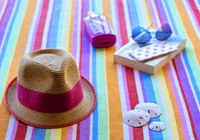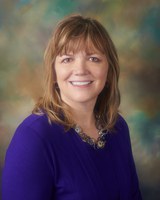Prairie Fare: May is Melanoma Awareness Month
(Click an image below to view a high-resolution image that can be downloaded)
“Are you cold?” someone asked me as I walked into a conference room.
“I’m OK,” I replied.
Yes, wearing a coat into the hotel conference room was a bit odd. In my defense, I was pulling a suitcase, holding a purse and carrying a large bag. I think he was just giving me a bad time. Being from the north, I often receive some references to temperature.
I removed my light winter coat and settled into my seat. I was wearing a sweater because a person has to be prepared for cold conference rooms.
Granted, flowers were blooming outside and people were wearing spring clothes, even shorts. At least, I was not wearing my full-length “super coat” that holds back blizzard-level winds.
I returned to Fargo to a thick blanket of snow, and I needed a warmer coat. I am hoping we are finally reaching warmer, sunnier days.
On the bright side, exposure to sunshine can replenish our vitamin D stores from the sun’s action on our skin. We need vitamin D to maintain our bones, immune system and reduce our risk for several diseases. Building our body’s vitamin D levels takes as little as 10 minutes of daily unprotected sun exposure (without sunscreen).
In cold wintery months, most of us need a vitamin D supplement.
We do not want to go overboard with sun exposure, though. May is melanoma and skin cancer awareness month. Every day, 9,500 Americans are diagnosed with skin cancer. Two Americans die of the disease every hour.
I really do not want to be the spoilsport for sunnier days. On the bright side, you can have fun in the sun while fishing, hiking, biking and gardening. However, we all need to take precautions, especially if we are among the people who work primarily in the sun. In North Dakota, for example, 26,000 farmers and ranchers work primarily outdoors.
Let’s try a short quiz in preparation for warm, sunny days to see what you remember about sun safety.
1. Which of the following puts you at greater risk for skin cancer, according to the Centers for Disease Control and Prevention?
- Light skin color
- Tendency to freckle
- Blue or green eyes
- Blonde or red hair
- Having lots of moles
- Family history of skin cancer
2. According to the Skin Cancer Foundation, which of the following is the statistic for the number of people who will develop skin cancer by age 70?
- 1 in 3
- 1 in 5
- 1 in 7
- 1 in 10
- 1 in 15
3. To help remember the warning signs of skin cancer, health experts recommend that we know the ABCDEs of melanoma. What do each of these letters stand for?
4. Name at least four actions you can take to help reduce your risk for skin cancer.
5. Are sun-tanning beds a safe alternative to sun exposure? Why or why not?
The answers:
- All of the items place you at higher risk; however, anyone can get skin cancer even people with darker skin and eyes.
- b. One in five Americans will develop skin cancer by age 70.
- Look for asymmetrical (A) moles with irregular shapes, a jagged or uneven border (B) on spots, or an uneven color (C). Examine your skin for spots with a diameter (D) larger than the size of a pea, and look for any spots that are evolving (E) or changing during the past weeks or months.
- Wear sunscreen with a sun protection factor of 30 or higher, according to the North Dakota Cancer Coalition. Stay in the shade as much as possible, especially during midday sun. Wear a head covering with a brim that shades your face, ears and neck. Ball caps do not provide this protection. Wear clothing that covers your arms and legs. Protect your eyes by wearing wrap-around shades that protect against UVA and UVB rays. See https://www.ndcancercoalition.org/ for more information.
- No, health experts warn against using tanning beds because they increase the risk for skin cancer, cataracts and eye cancer. The Food and Drug Administration lists tanning beds and sun lamps on their list of known carcinogens. Although some people consider a “base tan” from tanning beds as safe, health experts do not. Self-tanning lotions are available, which are considered a safer, FDA-approved alternative.
After some time in the sun with all the precautions, enjoy skin-healthy, vitamin-rich veggies and dip. This colorful recipe gets a thumbs-up from children, so adults will enjoy it, too.
Vegetable Dip Cups
24 whole green beans
1 red bell pepper
1 orange bell pepper
5 celery stalks
8 clear party cups (for serving)
Dip
1 cup fat-free cottage cheese
8-ounce carton plain Greek yogurt
0.4-ounce envelope ranch dry salad dressing mix
In a bowl, add the cottage cheese, plain Greek yogurt and ranch packet and mix to combine; set aside. After washing, cut the celery and bell peppers into strips. Place four tablespoons of the dip in the bottom of each party cup along with three to four strips of each vegetable.
Makes eight servings. Each serving has 100 calories, 0 g fat, 7 g protein, 12 g carbohydrate, 4 g fiber and 210 mg sodium.
(Julie Garden-Robinson, Ph.D., R.D., L.R.D., is a North Dakota State University Extension food and nutrition specialist and professor in the Department of Health, Nutrition and Exercise Sciences. Follow her on Twitter @jgardenrobinson)
NDSU Agriculture Communication – April 27, 2023
Source: Julie Garden-Robinson, 701-231-7187, julie.garden-robinson@ndsu.edu
Editor: Elizabeth Cronin, 701-231-7881, elizabeth.cronin@ndsu.edu




